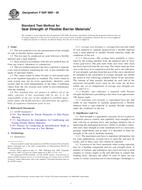We need your consent to use the individual data so that you can see information about your interests, among other things. Click "OK" to give your consent.
ASTM F88/F88M-09
Standard Test Method for Seal Strength of Flexible Barrier Materials
STANDARD published on 15.6.2009
The information about the standard:
Designation standards: ASTM F88/F88M-09
Note: WITHDRAWN
Publication date standards: 15.6.2009
SKU: NS-56789
The number of pages: 11
Approximate weight : 33 g (0.07 lbs)
Country: American technical standard
Category: Technical standards ASTM
Annotation of standard text ASTM F88/F88M-09 :
Keywords:
Flexible barrier materials, Sealability, Seal strength, ICS Number Code 55.040 (Packaging materials and accessories)
Additional information
| Significance and Use | ||||||
|
Seal strength is a quantitative measure for use in process validation, process control, and capability. Seal strength is not only relevant to opening force and package integrity, but to measuring the packaging processes' ability to produce consistent seals. Seal strength at some minimum level is a necessary package requirement, and at times it is desirable to limit the strength of the seal to facilitate opening. The maximum seal force is important information, but for some applications, average force to open the seal may be useful, and in those cases also should be reported. A portion of the force measured when testing materials may be a bending component and not seal strength alone. A number of fixtures and techniques have been devised to hold samples at various angles to the pull direction to control this bending force. |
||||||
| 1. Scope | ||||||
|
1.1 This test method covers the measurement of the strength of seals in flexible barrier materials. 1.2 The test may be conducted on seals between a flexible material and a rigid material. 1.3 Seals tested in accordance with this test method may be from any source, laboratory or commercial. 1.4 This test method measures the force required to separate a test strip of material containing the seal. It also identifies the mode of specimen failure. 1.5 The values stated in either SI units or inch-pound units are to be regarded separately as standard. The values stated in each system may not be exact equivalents; therefore, each system shall be used independently of the other. Combining values from the two systems may result in non-conformance with the standard. 1.6 This standard does not purport to address all of the safety concerns, if any, associated with its use. It is the responsibility of the user of this standard to establish appropriate safety and health practices and determine the applicability of regulatory limitations prior to use. |
||||||
| 2. Referenced Documents | ||||||
|
We recommend:
Technical standards updating
Do you want to make sure you use only the valid technical standards?
We can offer you a solution which will provide you a monthly overview concerning the updating of standards which you use.
Would you like to know more? Look at this page.




 Cookies
Cookies
